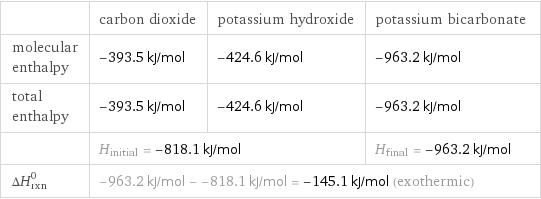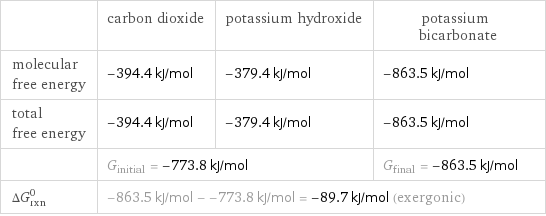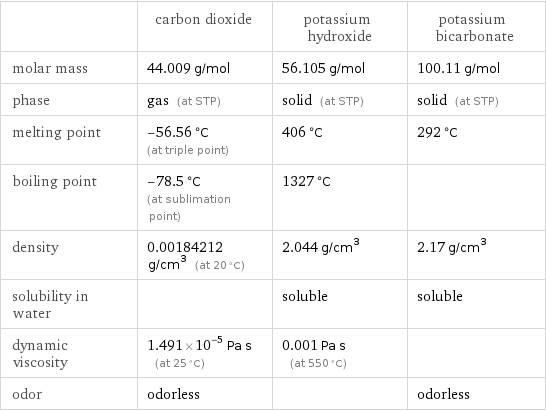Input interpretation

CO_2 carbon dioxide + KOH potassium hydroxide ⟶ KHCO_3 potassium bicarbonate
Balanced equation

Balance the chemical equation algebraically: CO_2 + KOH ⟶ KHCO_3 Add stoichiometric coefficients, c_i, to the reactants and products: c_1 CO_2 + c_2 KOH ⟶ c_3 KHCO_3 Set the number of atoms in the reactants equal to the number of atoms in the products for C, O, H and K: C: | c_1 = c_3 O: | 2 c_1 + c_2 = 3 c_3 H: | c_2 = c_3 K: | c_2 = c_3 Since the coefficients are relative quantities and underdetermined, choose a coefficient to set arbitrarily. To keep the coefficients small, the arbitrary value is ordinarily one. For instance, set c_1 = 1 and solve the system of equations for the remaining coefficients: c_1 = 1 c_2 = 1 c_3 = 1 Substitute the coefficients into the chemical reaction to obtain the balanced equation: Answer: | | CO_2 + KOH ⟶ KHCO_3
Structures

+ ⟶
Names

carbon dioxide + potassium hydroxide ⟶ potassium bicarbonate
Reaction thermodynamics
Enthalpy

| carbon dioxide | potassium hydroxide | potassium bicarbonate molecular enthalpy | -393.5 kJ/mol | -424.6 kJ/mol | -963.2 kJ/mol total enthalpy | -393.5 kJ/mol | -424.6 kJ/mol | -963.2 kJ/mol | H_initial = -818.1 kJ/mol | | H_final = -963.2 kJ/mol ΔH_rxn^0 | -963.2 kJ/mol - -818.1 kJ/mol = -145.1 kJ/mol (exothermic) | |
Gibbs free energy

| carbon dioxide | potassium hydroxide | potassium bicarbonate molecular free energy | -394.4 kJ/mol | -379.4 kJ/mol | -863.5 kJ/mol total free energy | -394.4 kJ/mol | -379.4 kJ/mol | -863.5 kJ/mol | G_initial = -773.8 kJ/mol | | G_final = -863.5 kJ/mol ΔG_rxn^0 | -863.5 kJ/mol - -773.8 kJ/mol = -89.7 kJ/mol (exergonic) | |
Equilibrium constant
![Construct the equilibrium constant, K, expression for: CO_2 + KOH ⟶ KHCO_3 Plan: • Balance the chemical equation. • Determine the stoichiometric numbers. • Assemble the activity expression for each chemical species. • Use the activity expressions to build the equilibrium constant expression. Write the balanced chemical equation: CO_2 + KOH ⟶ KHCO_3 Assign stoichiometric numbers, ν_i, using the stoichiometric coefficients, c_i, from the balanced chemical equation in the following manner: ν_i = -c_i for reactants and ν_i = c_i for products: chemical species | c_i | ν_i CO_2 | 1 | -1 KOH | 1 | -1 KHCO_3 | 1 | 1 Assemble the activity expressions accounting for the state of matter and ν_i: chemical species | c_i | ν_i | activity expression CO_2 | 1 | -1 | ([CO2])^(-1) KOH | 1 | -1 | ([KOH])^(-1) KHCO_3 | 1 | 1 | [KHCO3] The equilibrium constant symbol in the concentration basis is: K_c Mulitply the activity expressions to arrive at the K_c expression: Answer: | | K_c = ([CO2])^(-1) ([KOH])^(-1) [KHCO3] = ([KHCO3])/([CO2] [KOH])](../image_source/137440f0b09244bbb9d1d7257c1b0fe4.png)
Construct the equilibrium constant, K, expression for: CO_2 + KOH ⟶ KHCO_3 Plan: • Balance the chemical equation. • Determine the stoichiometric numbers. • Assemble the activity expression for each chemical species. • Use the activity expressions to build the equilibrium constant expression. Write the balanced chemical equation: CO_2 + KOH ⟶ KHCO_3 Assign stoichiometric numbers, ν_i, using the stoichiometric coefficients, c_i, from the balanced chemical equation in the following manner: ν_i = -c_i for reactants and ν_i = c_i for products: chemical species | c_i | ν_i CO_2 | 1 | -1 KOH | 1 | -1 KHCO_3 | 1 | 1 Assemble the activity expressions accounting for the state of matter and ν_i: chemical species | c_i | ν_i | activity expression CO_2 | 1 | -1 | ([CO2])^(-1) KOH | 1 | -1 | ([KOH])^(-1) KHCO_3 | 1 | 1 | [KHCO3] The equilibrium constant symbol in the concentration basis is: K_c Mulitply the activity expressions to arrive at the K_c expression: Answer: | | K_c = ([CO2])^(-1) ([KOH])^(-1) [KHCO3] = ([KHCO3])/([CO2] [KOH])
Rate of reaction
![Construct the rate of reaction expression for: CO_2 + KOH ⟶ KHCO_3 Plan: • Balance the chemical equation. • Determine the stoichiometric numbers. • Assemble the rate term for each chemical species. • Write the rate of reaction expression. Write the balanced chemical equation: CO_2 + KOH ⟶ KHCO_3 Assign stoichiometric numbers, ν_i, using the stoichiometric coefficients, c_i, from the balanced chemical equation in the following manner: ν_i = -c_i for reactants and ν_i = c_i for products: chemical species | c_i | ν_i CO_2 | 1 | -1 KOH | 1 | -1 KHCO_3 | 1 | 1 The rate term for each chemical species, B_i, is 1/ν_i(Δ[B_i])/(Δt) where [B_i] is the amount concentration and t is time: chemical species | c_i | ν_i | rate term CO_2 | 1 | -1 | -(Δ[CO2])/(Δt) KOH | 1 | -1 | -(Δ[KOH])/(Δt) KHCO_3 | 1 | 1 | (Δ[KHCO3])/(Δt) (for infinitesimal rate of change, replace Δ with d) Set the rate terms equal to each other to arrive at the rate expression: Answer: | | rate = -(Δ[CO2])/(Δt) = -(Δ[KOH])/(Δt) = (Δ[KHCO3])/(Δt) (assuming constant volume and no accumulation of intermediates or side products)](../image_source/874ef095340b83755b891bb1eb40471d.png)
Construct the rate of reaction expression for: CO_2 + KOH ⟶ KHCO_3 Plan: • Balance the chemical equation. • Determine the stoichiometric numbers. • Assemble the rate term for each chemical species. • Write the rate of reaction expression. Write the balanced chemical equation: CO_2 + KOH ⟶ KHCO_3 Assign stoichiometric numbers, ν_i, using the stoichiometric coefficients, c_i, from the balanced chemical equation in the following manner: ν_i = -c_i for reactants and ν_i = c_i for products: chemical species | c_i | ν_i CO_2 | 1 | -1 KOH | 1 | -1 KHCO_3 | 1 | 1 The rate term for each chemical species, B_i, is 1/ν_i(Δ[B_i])/(Δt) where [B_i] is the amount concentration and t is time: chemical species | c_i | ν_i | rate term CO_2 | 1 | -1 | -(Δ[CO2])/(Δt) KOH | 1 | -1 | -(Δ[KOH])/(Δt) KHCO_3 | 1 | 1 | (Δ[KHCO3])/(Δt) (for infinitesimal rate of change, replace Δ with d) Set the rate terms equal to each other to arrive at the rate expression: Answer: | | rate = -(Δ[CO2])/(Δt) = -(Δ[KOH])/(Δt) = (Δ[KHCO3])/(Δt) (assuming constant volume and no accumulation of intermediates or side products)
Chemical names and formulas

| carbon dioxide | potassium hydroxide | potassium bicarbonate formula | CO_2 | KOH | KHCO_3 Hill formula | CO_2 | HKO | CHKO_3 name | carbon dioxide | potassium hydroxide | potassium bicarbonate IUPAC name | carbon dioxide | potassium hydroxide | potassium hydrogen carbonate
Substance properties

| carbon dioxide | potassium hydroxide | potassium bicarbonate molar mass | 44.009 g/mol | 56.105 g/mol | 100.11 g/mol phase | gas (at STP) | solid (at STP) | solid (at STP) melting point | -56.56 °C (at triple point) | 406 °C | 292 °C boiling point | -78.5 °C (at sublimation point) | 1327 °C | density | 0.00184212 g/cm^3 (at 20 °C) | 2.044 g/cm^3 | 2.17 g/cm^3 solubility in water | | soluble | soluble dynamic viscosity | 1.491×10^-5 Pa s (at 25 °C) | 0.001 Pa s (at 550 °C) | odor | odorless | | odorless
Units
